Sustainability
The residence incorporates a diverse set of sustainable strategies aimed at not only reducing the project's energy footprint, but also providing a sustainable lifestyle for the inhabitants.
Aside from energy and water consumption, the project approaches sustainability as a process of integrating the ecosystems of the site and the daily lives of the residents. Wherever possible the project dematerializes the boundaries between the built and natural environments, providing connections between the interior and exterior. The house's landscaping is designed to respect the local climate and to provide food for the residents.

The Peninsula Residence incorporates three green roofs or rooftops gardens. A sedum garden is located off of the second floor bedrooms. An ornamental garden complements the outdoor living spaces on the lakeside sky deck, and a functional vegetable garden provides fresh, organic food throughout the year. All green roofs incorporate water-saving drip irrigation and plants well suited to the micro-climate of each rooftop garden.
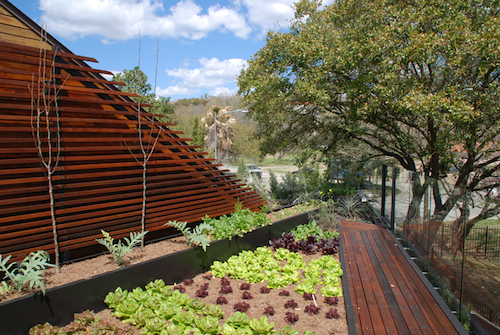
The landscaping includes multiple gardens, including herb gardens, ornamental gardens, and productive fruit and olive trees. In addition, a green roof vegetable garden located above the master suite produces vegetables throughout the year. Through the use of carefully designed planting beds and modern green roof techniques, the 150 square feet of green roof vegetable garden produces enough vegetables to consistently provide for a family of four.
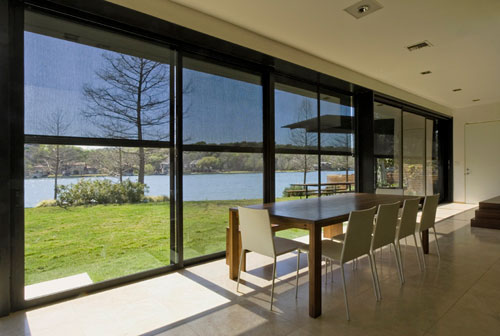
Because of the significant glazing facing the lake, the Peninsula residence uses a tiered approach to shading and reduction of heat gain. The landscaping is specifically designed to shade the harsh late afternoon sun in the summer but allow sunlight in the winter. All glazing is Low-E, tinted, double pane glass, which significantly reduces the heat load. Finally, all south or west facing widows are equipped with exterior roll down shades. These automated shades are used one or two hours each day to reduce heat load when the sun shines directly in the home. Because these are exterior shades, they reduce 95% of the heat gain while preserving the view.
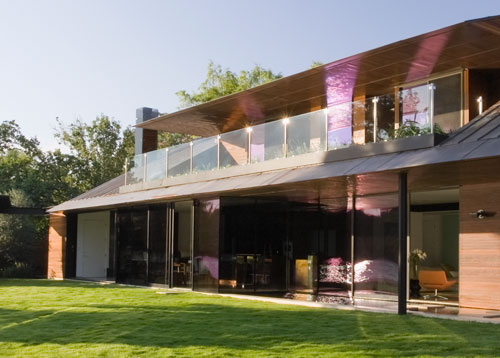
The use of tinted, Low-E glass, combined with other active and passive shading strategies, allows the owner to enjoy incredible views from every room while consuming no more energy than an equivalent traditional home of the same size.
Shading
Because of the significant glazing facing the lake, the Peninsula residence uses a tiered approach to shading and reduction of heat gain.
The landscaping is specifically designed to shade the harsh late afternoon sun in the summer but allow sunlight in the winter. All glazing is Low-E, tinted, double pane glass which significantly reduces the heat load. Finally, all south or west facing widows are equipped with exterior roll down shades.
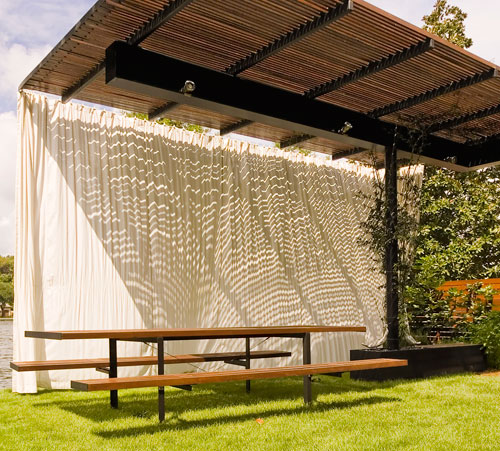
A retractable curtain provides shading for the picnic table during the late afternoon and evening
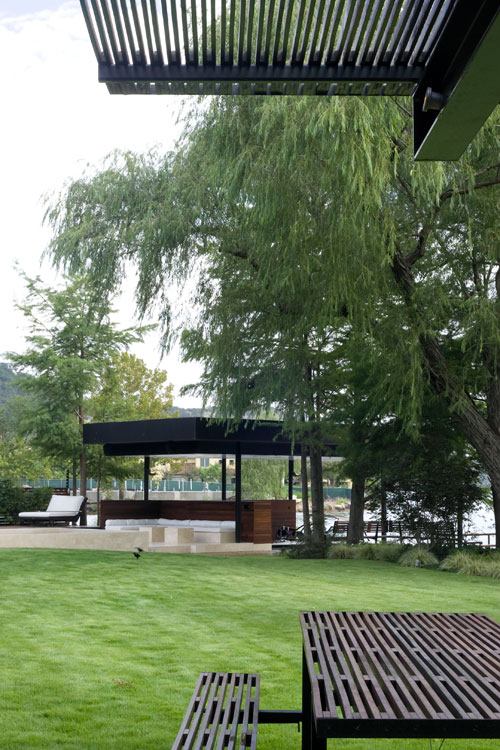
The slated trellis mirrors the picnic table below, supports a massive flowering rose vine, and shades the picnic area.
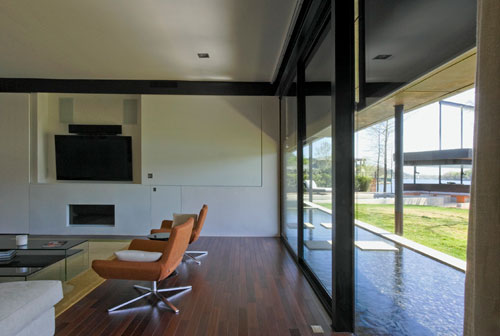
The covered reflecting pond shades the living room and master bedroom.
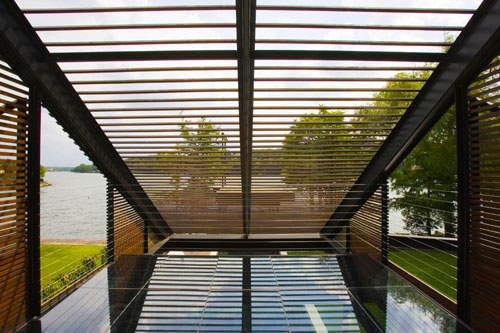
The shade structure over the solarium shades the all-glass structure and provides a pleasant seating area in the rooftop vegetable garden.
Pool
The reflecting pond and pool provide a design connection to the lake.
The reflecting pond flows in front of the public spaces, past the master bedroom and then cascades into the pool. The pool itself surrounds the master bedroom and solarium and extends out to the lakeside boat dock and sky deck. Because of its close connection to the home, the pool had to serve both a design and functional purpose. At first, the pool appears to be a continuation of the shallow reflecting pond. This effect is achieved by using polished black stones in the reflecting pond and black Pebble Tec plaster in the pool. It is only upon closer inspection that one realizes that it is a large 45 by 13 foot recreation pool. Throughout the day and night, the sun and interior lights reflect off the water creating shifting patterns within the home.
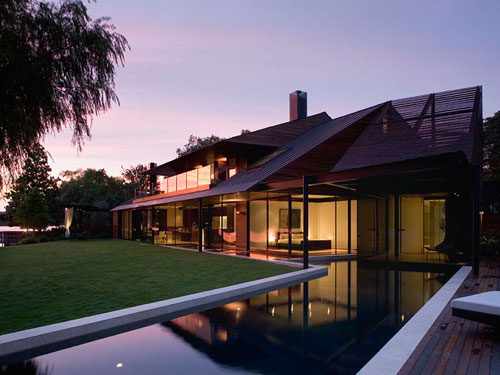
The reflecting pond and pool wrap around the master bedroom and living space, and visually connect the home to the lake.
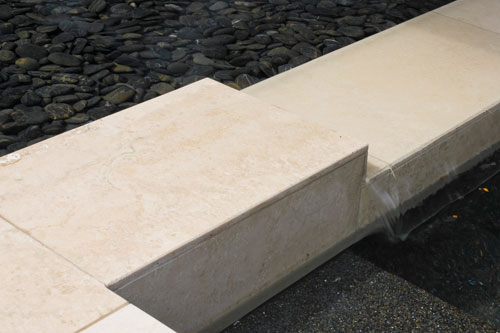
The reflecting pond overflows into the pool. The pool and reflecting pond are serviced by commercial quality filtration and sanitization systems.
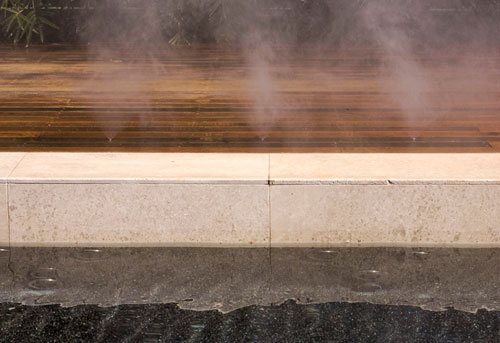
The pool is surrounded by a fogging/misting system. During the summer months, the misting system drops the poolside temperature by 20 degrees and provides a spa like setting.
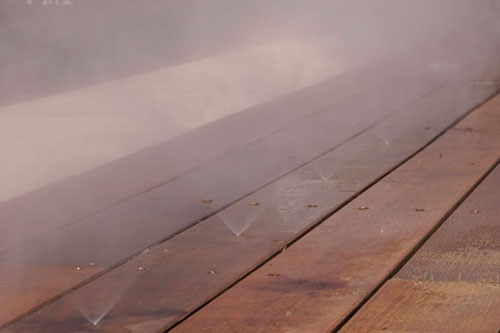
The misting system is concealed in the pool deck and creates a cool, rain forest effect with the flip of a switch

A custom manufactured swim jet is integrated into the end of the pool. Unlike mass-produced systems that are visually distracting, the narrow stainless steel jet is invisible, but produces a current that allows the athlete to endlessly swim in place.
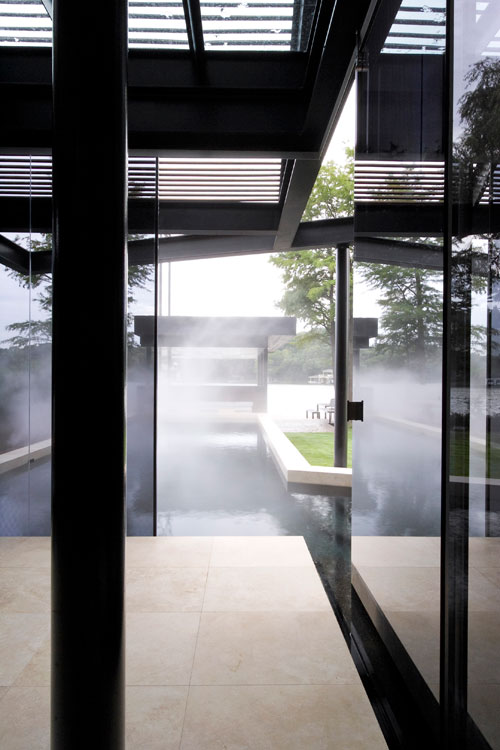
The solarium is an indoor/outdoor room that opens to the pool and boat dock beyond. The solarium can be heated or cooled as desired, but the room is designed to be exposed to the extremes of the elements as well.
Lighting
Rather than treating lighting as an after-thought, the Peninsula Residence was designed from the beginning with lighting in mind.
The material choices and layout were chosen to work with a sophisticated array of illumination sources, from low energy LED lights to fluorescent wall washes to adjustable spot lights. The visual experience of the project is inherently an experience of light, and the design reflects an acute attention to this fact.
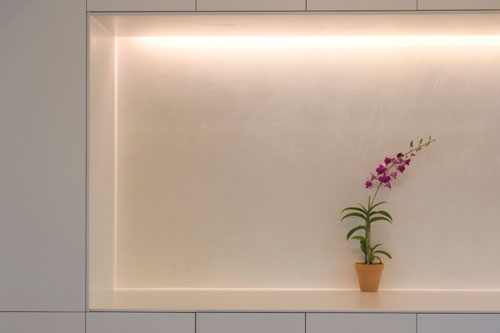
The Peninsula Residence treats lighting as integral to the overall design. Lighting becomes a central element of the residence. In the dining room, concealed LED lights from Color Kinetics wash a polished plaster wall. The acute angle of the lighting highlights the natural mottling present in the plaster finish, creating an engaging art installation while serving a essential lighting function.
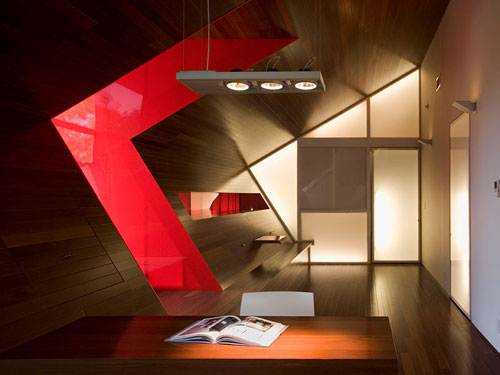
In the children's library, located on the second floor, lighted acrylic panels emphasize the geometry of a recessed sitting area.
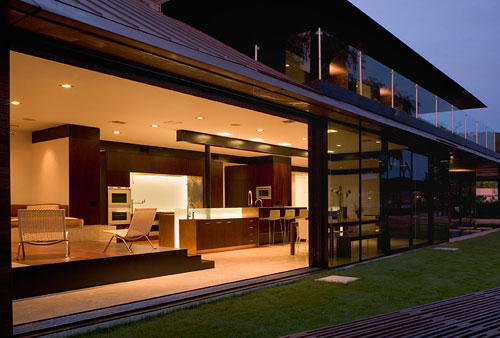
At night, the home comes alive from the exterior view. The view into the home at night from the multiple outdoor recreation areas is as dramatic as the view from the home during the day.
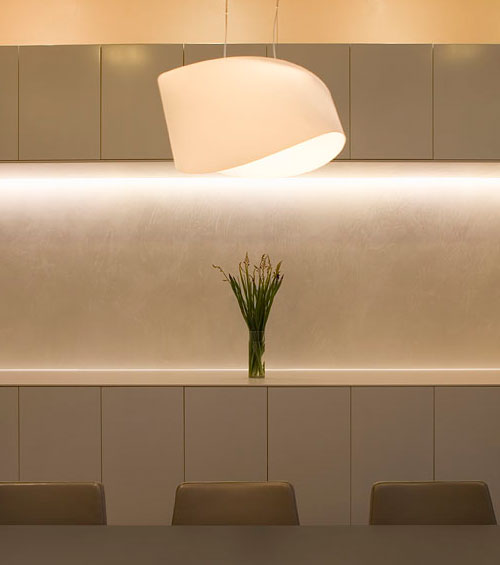
The use multiple lighting elements in the dining room creates an intimate environment that encourages easy communication and the exchange of ideas.
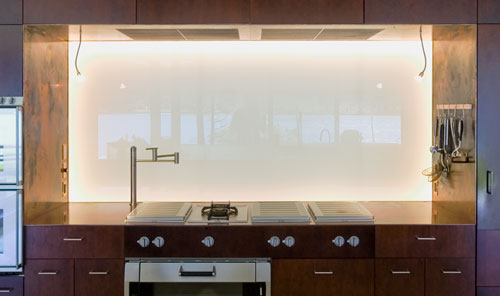
The lighted backsplash in the kitchen cook center illustrates the approach to lighting. The single piece of etched glass provides an easy to maintain backsplash surface. The diffuse quality of the surface gently reflects the exterior lake view, providing an ever-shifting scene. The concealed low energy LED lighting provides a comfortable and diffuse functional light source for cooking.
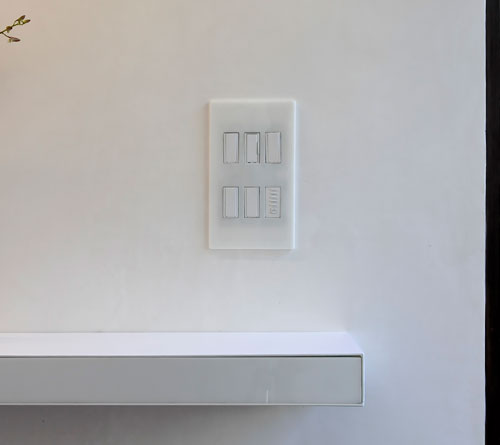
Many components used in the detailed finish of the home were manufactured on-site by skilled craftsmen. Here, something as simple as a switch cover becomes an opportunity to amplify the qualities of the home
Kitchen
Kitchens inevitably become the focal point of family life and entertaining.
The project accepted this inevitability and moved the kitchen away from current trend of hulking, commercial appliances. The project treats each component in the kitchen as fine furniture, creating a functional, inviting and warm space. The kitchen features top of the line Gaggeneau, SubZero and Dacor appliances yet the appliances are hidden whenever possible. The residence has five ovens, a cooktop featuring five burners and a grill, two fridge/freezer units, a 120 bottle wine cooler, three dishwashers, four sinks, and two warming drawers. All of these elements are integrated into the design. The most demanding chef would find everything required, but the functional aspects do not overwhelm the design
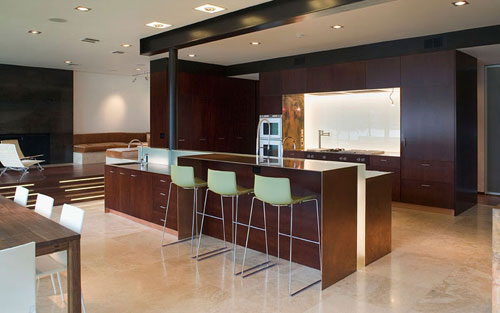
The kitchen utilizes the material palette used throughout the project. The cabinetry is massaranduba, which is used for exterior siding and decking. The countertops are custom copper slabs (not veneered) which are allowed to oxidize, providing a contrast to the etched glass backsplash and spines. The etched glass both provides a lighting source and reflects the exterior views.

The kitchen design employs a work station approach, with distinct cooking, food preparation, baking, food storage and entertainment centers. These centers relate to each other naturally. As a result, the kitchen can accommodate multiple people. The chef can prepare a meal while comfortable surrounded by guests. The cook center features a custom integrated ventilation system, and a lighted etched glass backsplash that reflects the lake views in unexpected ways.
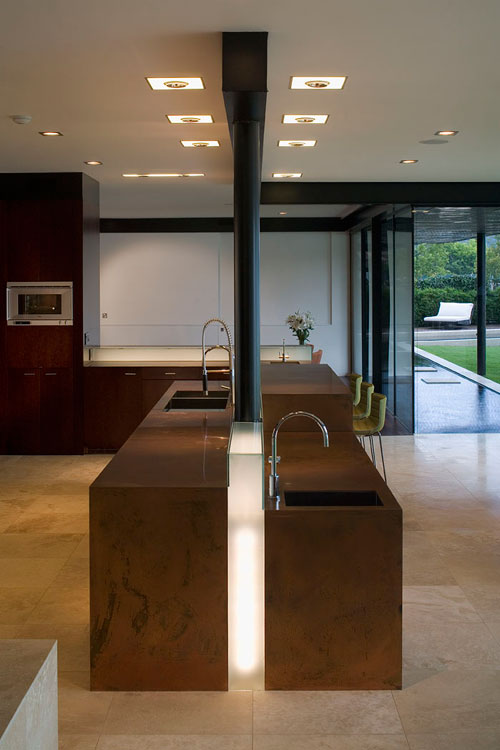
The food preparation and baking centers are separated by a spine of light, which serves both a functional and aesthetic purpose.
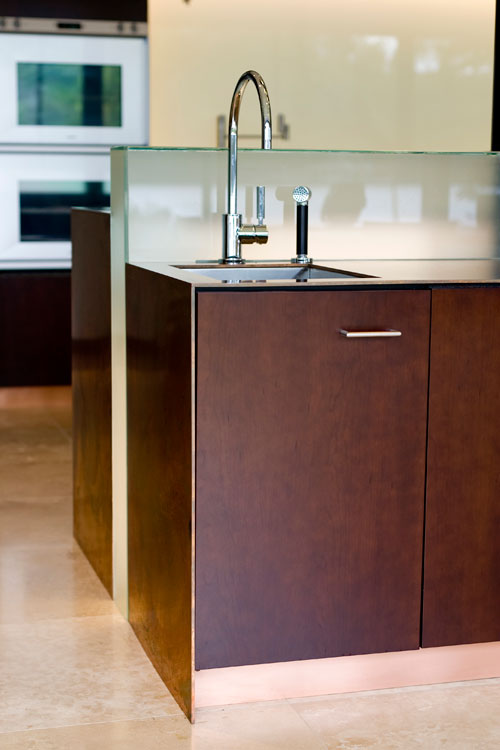
Careful attention to detail imbues the kitchen cabinetry with a fine furniture or art quality. Solid slab copper countertops and side panels envelope the European style cabinets, which is finished with a copper toe-kick and etched glass spine. Each element serves both a functional and aesthetic purpose. The etched glass spine is an easy to maintain backsplash surface and provides task lighting through internal LED lighting, but gives the large work centers a light and abstract quality.
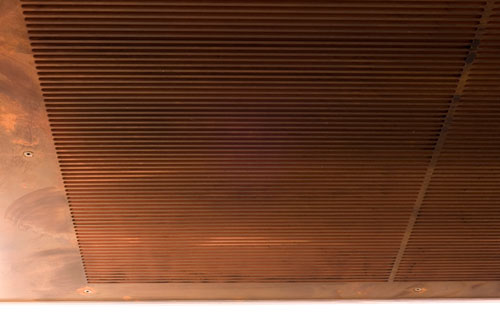
Rather than using a standard commercial vent hood, the ventilation system was integrated into the cook center design. Water-jet cut copper panels conceal ventilation filters, which are accessible through touch latch doors. The ventilation fan itself is mounted on the exterior roof, which reduces ventilation noise to whisper quiet levels.